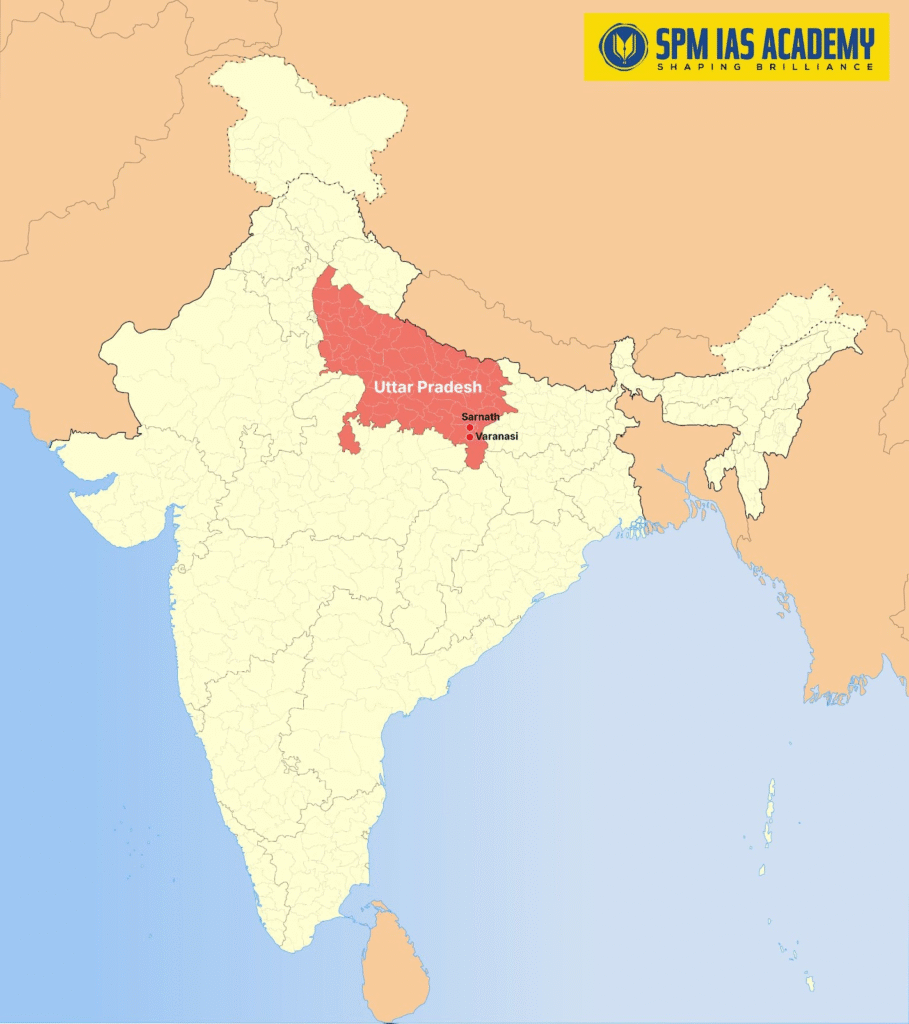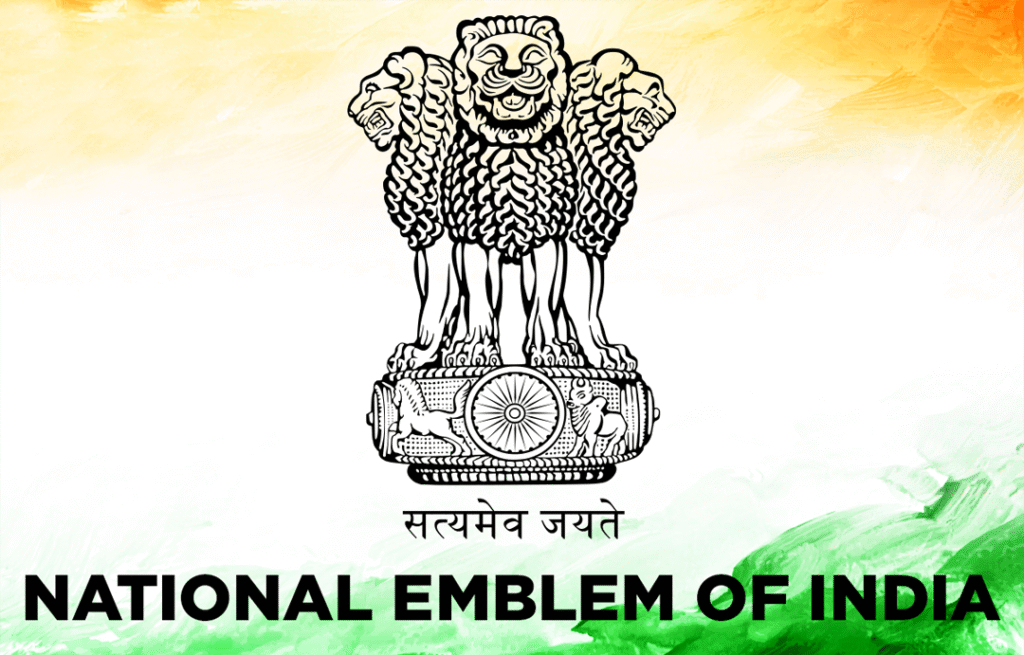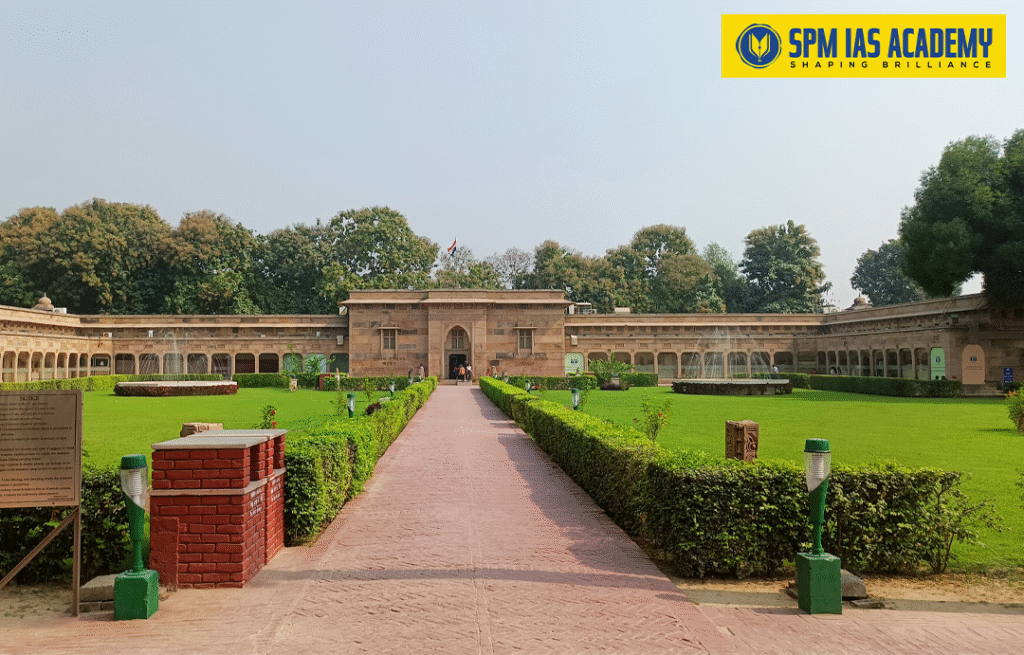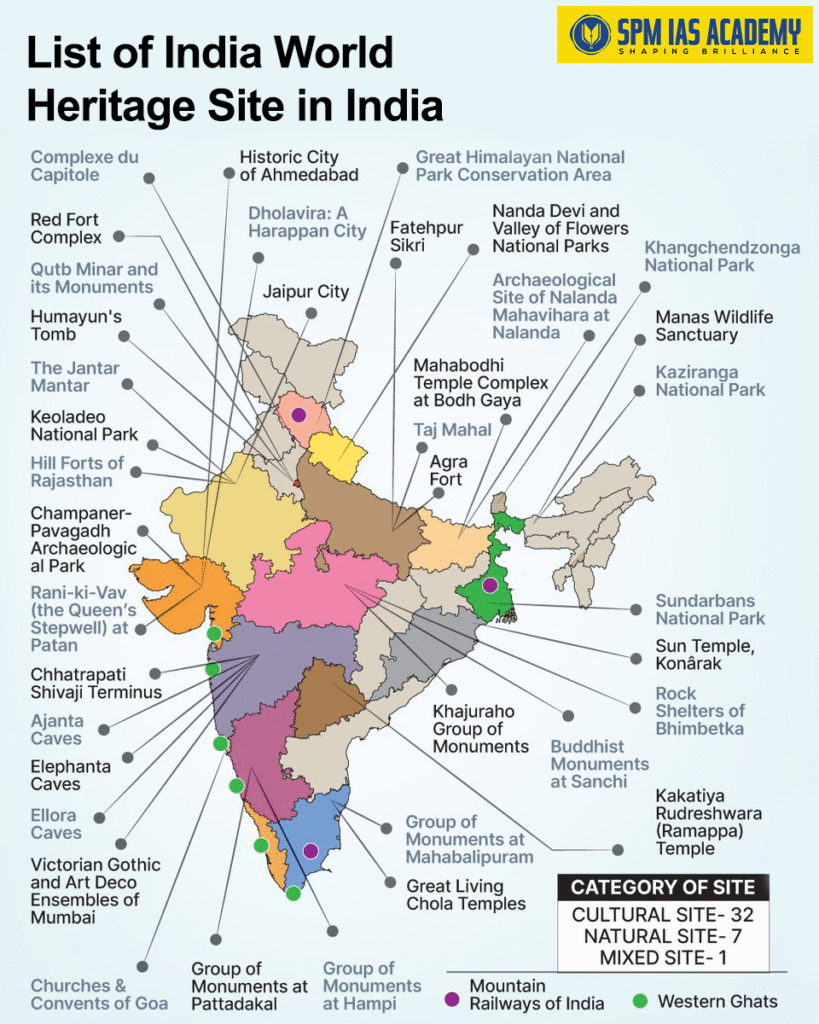India has officially nominated the ancient Buddhist site Sarnath for the UNESCO World Heritage List under the 2025-26 nomination cycle. The place is located in Uttar Pradesh, near Varanasi. In this article, we will discuss the nomination of Sarnath for the UNESCO World Heritage List, highlighting its historical, cultural, and religious significance. It aims to explain why Sarnath holds a central place in Buddhist heritage, outline its key monuments like the Dhamek Stupa and Ashokan Pillar, and discuss how UNESCO recognition can enhance its global prominence and preservation efforts.

Quick Facts for Exam Preparation
Location: Sarnath is situated at the confluence of the Rivers Ganga and Varuna in Varanasi, Uttar Pradesh
Historical Significance: Sarnath is where Gautama Buddha delivered his first sermon (Dhammachakkappavattana) after enlightenment
Current Status: Listed on UNESCO tentative list India since 1998
Nominating Agency: Archaeological Survey of India (ASI), Ministry of Culture, Government of India
Historical and Religious Significance
The Sacred Sarnath Pilgrimage Site
Gautama Buddha delivered his first religious speech (first sermon) in Sarnath, following the attainment of enlightenment at Bodh Gaya (Bihar), marking the birth of Buddhist community. This makes the ancient Buddhist site Sarnath one of the most important locations in Buddhist history and a major Sarnath pilgrimage site for devotees worldwide
.
Etymology and Alternative Names
Sarnath is also known by names such as Rishipatana, Mrigadava, and Mrigadaya. The modern name is believed to be derived from Saranganatha (“Lord of the Deer”).
Four Sacred Buddhist Sites
Sarnath is one of the 4 key pilgrimage sites in Buddhism, along with Lumbini, Bodh Gaya, and Kushinagar, associated with the birth, enlightenment, first sermon, and death of Buddha respectively.
Key Archaeological Monuments and Structures
Major Stupas and Structures
- Dhamek Stupa
- Built around 500 CE, the Dhamek Stupa historical significance lies in marking the exact spot of Buddha’s first sermon
- Height: 43.6 meters
- Diameter: 27.5 meters at base
- Critical for Sarnath plaque revision and archaeological understanding

- Chaukhandi Stupa
- Built around the 5th century AD to honor Lord Buddha, it is a tall brick structure with an octagonal tower on top
- This tower was added later, in 1588 by Govardhan, the son of Raja Todarmal to remember Humayun’s visit to Sarnath
- Dharmarajika Stupa
- Originally built by Mauryan Emperor Ashoka in the 3rd century BCE to house the relics of Buddha
- Ashokan Pillar Sarnath
- The famous Ashokan Pillar Sarnath bears Ashoka’s edict and originally crowned by the Lion Capital, now India’s National Emblem
- Represents imperial patronage and Buddhist heritage

Museums and Modern Structures
Sarnath Archaeological Museum
- The Sarnath Archaeological Museum houses the original Lion Capital, along with other important artefacts

- Sarnath Museum, first site museum of ASI, which accommodates the original Lion Capital, and sculptures
Mulagandha Kuti Vihar
- The Mulagandha Kuti Vihar, built by the Mahabodhi Society, contains vibrant frescoes narrating Buddha’s life
- Mulagandha Kuti Vihara, a temple built in 1931 by Japanese artist Kosetsu Nosu
Historical Timeline and Patronage
Ancient Period
- 3rd Century BCE: Emperor Ashoka promoted Buddhism after the Kalinga War and built stupas and monasteries at Sarnath
- Mauryan Era: Extensive construction under Ashoka’s patronage
- Post-Mauryan Period: Sarnath flourished under rulers like the Kushans, Guptas, and Harshavardhana, who restored structures post Huna invasions
Colonial Archaeology India and Modern Rediscovery
The rediscovery of Sarnath represents a significant chapter in colonial archaeology India. British archaeologists in the 19th century conducted extensive excavations, often linked to colonial administrative interests. The ASI decolonization history shows how post-independence India has worked to reclaim and reinterpret these archaeological sites from an indigenous perspective.
Local Patronage and Benares Connection Historical records indicate connections between Sarnath and local ruling families, including references to Babu Jagat Singh Sarnath and the broader Benares ruler family history. These connections highlight the continuity of reverence for the site across different periods of Indian history.
UNESCO World Heritage Framework
About UNESCO World Heritage Sites
UNESCO World Heritage Sites are locations of exceptional cultural or natural significance, officially designated under the World Heritage Convention, 1972 for their value to all humanity.

India’s Status
- India ratified the Convention in 1977, joining 195 other countries in this global commitment
- Currently, 42 Indian sites, comprising 34 cultural, 7 natural, and 1 mixed have been inscribed on the UNESCO World Heritage List
- India currently ranks 6th globally and 2nd in the Asia-Pacific in terms of the number of UNESCO World Heritage Sites, and has 62 sites on its Tentative List
UNESCO World Heritage Process
The UNESCO World Heritage process for the Sarnath UNESCO World Heritage nomination involves multiple stages of evaluation and assessment.
Key Rules and Timeline
- Under the Convention, each State Party can nominate only one site per year for inscription on the World Heritage List
- The nomination process takes approximately 1.5 years from the date of submission
Evaluation Bodies The dossier is then evaluated by Advisory Bodies such as:
- ICOMOS (International Council on Monuments and Sites) (for cultural sites)
- IUCN (International Union for Conservation of Nature) (for natural sites)
- ICCROM, which provides technical expertise and training in conservation
Final Decision The World Heritage Committee, which meets annually, makes the final decision. It can inscribe, defer, or request more information. India is a current member (2021–25) of this Committee, contributing to global heritage governance.
Nodal Agency The ASI is the nodal agency for all World Heritage matters in India.
Indian Sites in the UNESCO World Heritage List
- Total Sites (as of 2025): 44
- Cultural Sites: 36
- Natural Sites: 7
- Mixed Site: 1 (Khangchendzonga National Park, Sikkim)
- Most Recent Addition (2025): The Maratha Military Landscapes – a network of 12 forts across Maharashtra, inscribed in July 2025.
- Tentative List: India has 62 sites on its Tentative List – a mandatory stage before formal nomination.
- Nodal Agency: The Archaeological Survey of India (ASI), under the Ministry of Culture, is the nodal agency for all World Heritage matters in India.

| Site | State |
|---|---|
| Ajanta Caves | Maharashtra |
| Ellora Caves | Maharashtra |
| Agra Fort | Uttar Pradesh |
| Taj Mahal | Uttar Pradesh |
| Sun Temple, Konârak | Odisha |
| Group of Monuments at Mahabalipuram | Tamil Nadu |
| Kaziranga National Park | Assam |
| Manas Wildlife Sanctuary | Assam |
| Keoladeo National Park | Rajasthan |
| Churches and Convents of Goa | Goa |
| Khajuraho Group of Monuments | Madhya Pradesh |
| Group of Monuments at Hampi | Karnataka |
| Fatehpur Sikri | Uttar Pradesh |
| Group of Monuments at Pattadakal | Karnataka |
| Elephanta Caves | Maharashtra |
| Great Living Chola Temples | Tamil Nadu |
| Sundarbans National Park | West Bengal |
| Nanda Devi and Valley of Flowers National Parks | Uttarakhand |
| Buddhist Monuments at Sanchi | Madhya Pradesh |
| Humayun’s Tomb, Delhi | Delhi |
| Qutb Minar and its Monuments, Delhi | Delhi |
| Mountain Railways of India | West Bengal, Tamil Nadu, Himachal Pradesh |
| Mahabodhi Temple Complex at Bodh Gaya | Bihar |
| Rock Shelters of Bhimbetka | Madhya Pradesh |
| Chhatrapati Shivaji Terminus (formerly Victoria Terminus) | Maharashtra |
| Champaner-Pavagadh Archaeological Park | Gujarat |
| Red Fort Complex | Delhi |
| The Jantar Mantar, Jaipur | Rajasthan |
| Western Ghats | Maharashtra, Karnataka, Kerala, Tamil Nadu |
| Hill Forts of Rajasthan | Rajasthan |
| Rani-ki-Vav at Patan, Gujarat | Gujarat |
| Great Himalayan National Park Conservation Area | Himachal Pradesh |
| Nalanda Mahavihara at Nalanda, Bihar | Bihar |
| Khangchendzonga National Park | Sikkim |
| The Architectural Work of Le Corbusier | Chandigarh |
| Ahmadabad | Gujarat |
| Victorian Gothic and Art Deco Ensembles of Mumbai | Maharashtra |
| Jaipur City | Rajasthan |
| Kakatiya Rudreshwara (Ramappa) Temple, Telangana | Telangana |
| Dholavira: a Harappan City | Gujarat |
| Santiniketan | West Bengal |
| Sacred Ensembles of the Hoysalas | Karnataka |
| Moidams – the Mound-Burial system of the Ahom Dynasty | Assam |
| Maratha Military Landscapes | Maharashtra |
Significance for Tourism and Economy
Cultural Tourism Potential
The UNESCO recognition is expected to significantly boost Buddhist circuit tourism, attracting pilgrims and cultural tourists from around the world.
Economic Impact
Local communities and businesses are likely to benefit from increased tourist footfall, creating employment opportunities and promoting local crafts.
Important Points for UPSC Civil Services Preparation
Static GK Points for Sarnath Plaque Revision
- Four Buddhist Pilgrimage Sites: Lumbini (Birth), Bodh Gaya (Enlightenment), Sarnath (First Sermon), Kushinagar (Death)
- Lion Capital: National Emblem of India, originally from the Ashokan Pillar Sarnath
- First Sermon: Dhammachakkappavattana Sutta (Turning the Wheel of Dharma)
- Alternative Names: Rishipatana, Mrigadava, Mrigadaya, Saranganatha, Sarnat (archaic form)
- Archaeological Significance: Dhamek Stupa historical significance in Buddhist architecture
Current Affairs Component for GS Paper 1 History
- 2025 nomination under 2025-26 cycle
- India’s 6th global ranking in World Heritage Sites
- ASI as nodal agency for heritage matters and ASI decolonization history initiatives
- India’s membership in World Heritage Committee (2021-25)
- UNESCO tentative list India status since 1998
Conclusion
The Sarnath UNESCO World Heritage nomination represents not just recognition of its historical and religious significance, but also highlights India’s commitment to preserving its Buddhist heritage. For UPSC Civil Services preparation, particularly for GS Paper 1 history, this development brings together multiple dimensions – ancient history, cultural heritage, current affairs, and international relations.The site’s eventual inscription would further strengthen India’s position in global heritage preservation and boost the country’s soft power through cultural diplomacy.
For aspirants focusing on Sarnath plaque revision, remember that this ancient Buddhist site Sarnath connects various historical themes – from Mauryan patronage to colonial archaeology India, and from ASI decolonization history to contemporary cultural diplomacy. The Sarnath pilgrimage site continues to be relevant in modern geopolitics, making it a crucial topic for comprehensive exam preparation.
Key Terms Glossary for UPSC Civil Services Preparation
- Dhammachakkappavattana: First sermon by Buddha, “Turning the Wheel of Dharma”
- Sangha: Buddhist community of monks
- ICOMOS: International Council on Monuments and Sites
- IUCN: International Union for Conservation of Nature
- ICCROM: International Centre for Conservation and Restoration of Cultural Property
- UNESCO Tentative List India: Preliminary list of sites India intends to nominate
- ASI: Archaeological Survey of India
- Colonial Archaeology India: British-era archaeological practices and their impact
- ASI Decolonization History: Post-independence efforts to reinterpret Indian heritage
- Sarnat: Archaic/alternative spelling sometimes found in historical texts
Also Read:












